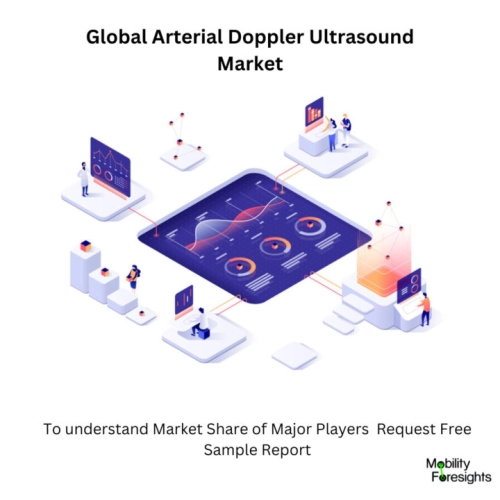
- Get in Touch with Us

Last Updated: Apr 25, 2025 | Study Period: 2024-2030
A non-invasive imaging procedure called arterial Doppler ultrasound is used to assess blood flow through the body's arteries.
The test creates images of the arteries and measures the speed and direction of blood flow using high-frequency sound waves that are generated by a portable device known as a transducer.
The transducer is positioned on the skin over the artery under investigation and moved back and forth throughout the test to acquire images from various perspectives.
Additionally, the transducer emits sound waves, which are reflected off the flowing blood cells in the artery and used to measure and display the rate and direction of blood flow.
Peripheral artery disease (PAD), carotid artery disease, and aneurysms are just a few of the disorders that can be diagnosed using arterial Doppler ultrasound. The test can assist detect irregularities in blood flow as well as blockages or constriction in the arteries.
A safe and painless diagnostic that doesn't require radiation or contrast dye is arterial Doppler ultrasonography. Depending on how many arteries are being investigated, the test normally takes 30 to 60 minutes to complete.
Results are frequently instantly available and can be used to direct additional testing or therapy. A properly qualified ultrasound technician or radiologist normally conducts the exam.

The Global Arterial Doppler Ultrasound Market accounted for $XX Billion in 2023 and is anticipated to reach $XX Billion by 2030, registering a CAGR of XX% from 2024 to 2030.
New doppler ultrasound systems, like the "M6 Colour Doppler Ultrasound System," have been introduced by Koninklijke Philips.
In order to create a single image, this system allows the use of different scanned angles. As a result, this system continuously monitors the colour flow and optimises the ideal Colour box position and angle during real-time scanning.
It is an extremely cost-effective device with good image quality, strong functionality, and a stylish design.
ACUSON NX3 system, among other new doppler systems, have been introduced by Siemens Healthcare. With its extensive transducer library, this system aids in reducing exam discrepancies and improving the ability to possibly identify and characterise more.
In order to lessen speckle, clutter, and increase the continuity of specular reflectors, GE Healthcare has introduced novel doppler techniques, such as "CrossXBeam," which is a spatial compounding approach of obtaining and integrating ultrasound information in real-time.
| Sl no | Topic |
| 1 | Market Segmentation |
| 2 | Scope of the report |
| 3 | Abbreviations |
| 4 | Research Methodology |
| 5 | Executive Summary |
| 6 | Introduction |
| 7 | Insights from Industry stakeholders |
| 8 | Cost breakdown of Product by sub-components and average profit margin |
| 9 | Disruptive innovation in the Industry |
| 10 | Technology trends in the Industry |
| 11 | Consumer trends in the industry |
| 12 | Recent Production Milestones |
| 13 | Component Manufacturing in US, EU and China |
| 14 | COVID-19 impact on overall market |
| 15 | COVID-19 impact on Production of components |
| 16 | COVID-19 impact on Point of sale |
| 17 | Market Segmentation, Dynamics and Forecast by Geography, 2024-2030 |
| 18 | Market Segmentation, Dynamics and Forecast by Product Type, 2024-2030 |
| 19 | Market Segmentation, Dynamics and Forecast by Application, 2024-2030 |
| 20 | Market Segmentation, Dynamics and Forecast by End use, 2024-2030 |
| 21 | Product installation rate by OEM, 2023 |
| 22 | Incline/Decline in Average B-2-B selling price in past 5 years |
| 23 | Competition from substitute products |
| 24 | Gross margin and average profitability of suppliers |
| 25 | New product development in past 12 months |
| 26 | M&A in past 12 months |
| 27 | Growth strategy of leading players |
| 28 | Market share of vendors, 2023 |
| 29 | Company Profiles |
| 30 | Unmet needs and opportunity for new suppliers |
| 31 | Conclusion |
| 32 | Appendix |